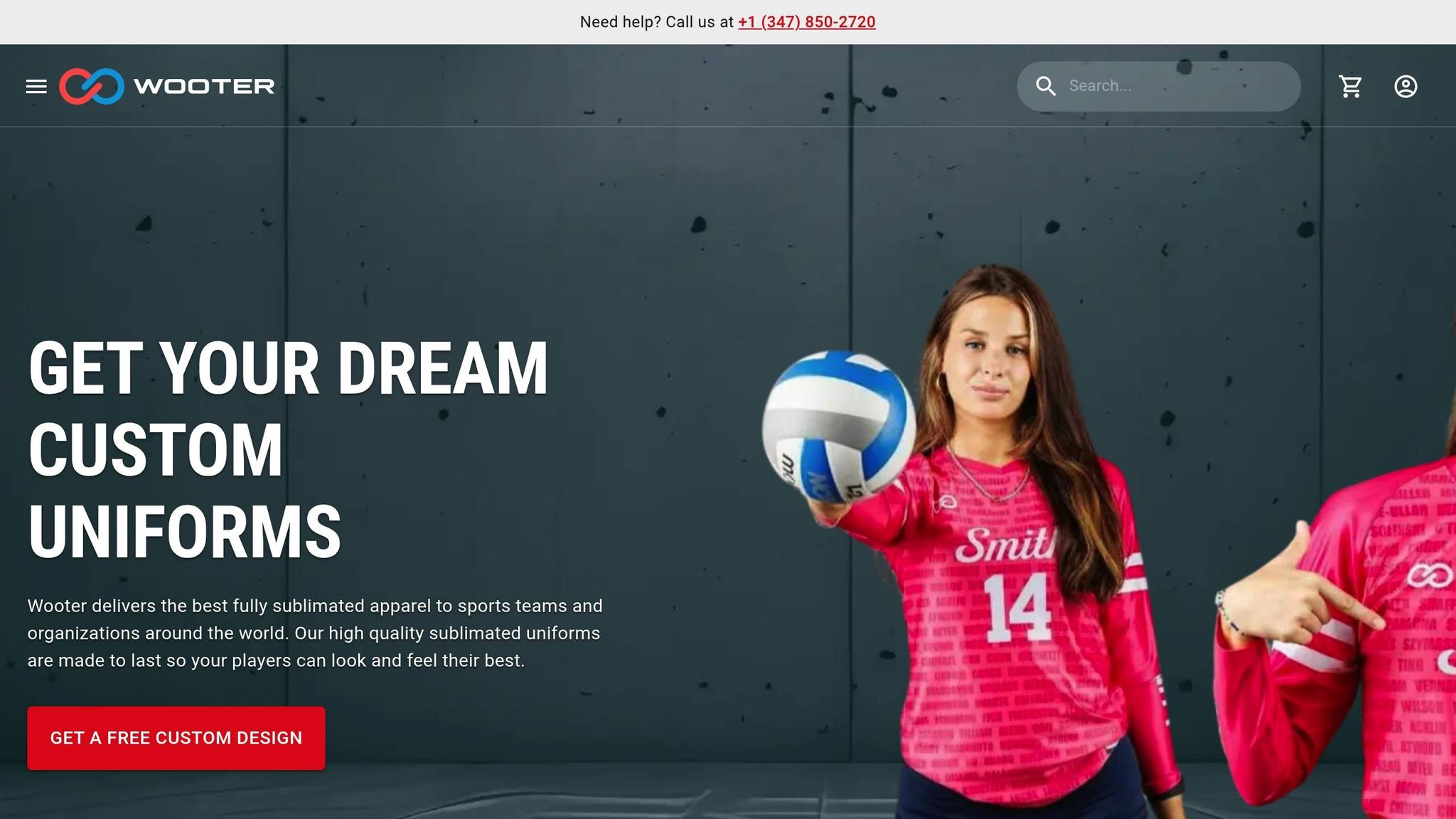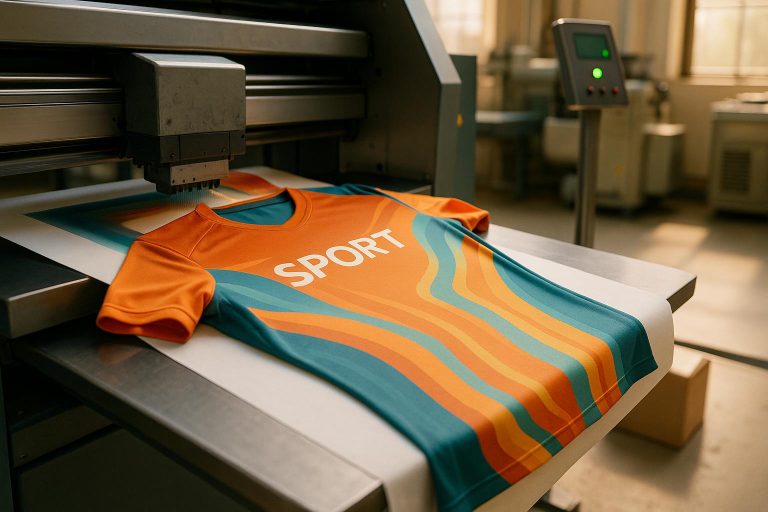Sublimation printing is transforming sportswear production by cutting energy use and waste. Unlike older methods, it embeds designs directly into polyester fabrics using heat and gas, skipping water-intensive and high-energy processes. Here’s why this matters:
- Energy Savings: Operates at lower temperatures and eliminates extra steps like washing and steaming.
- Water-Free Process: No water is required for dyeing, reducing water waste by up to 96%.
- Durable Designs: Prints last through 50+ washes without fading or cracking.
- Eco-Friendly Inks: Uses water-based, non-toxic inks, lowering carbon emissions by 30–40%.
- Localized Production: Reduces transportation energy by combining printing and assembly in one location.
Sublimation is leading the way for energy-efficient, durable, and vibrant sportswear, benefiting both manufacturers and athletes.
How to make clothing with sublimation | The sublimation process
How Sublimation Printing Reduces Energy Use
Sublimation printing builds on energy-saving principles by introducing innovative processes that cut down on energy consumption. It achieves this by simplifying production, operating at lower temperatures, and reducing the need for extensive transportation.
Streamlined Two-Step Process Saves Energy
The two-step process of sublimation printing is a game-changer for energy efficiency. Unlike traditional methods that involve multiple energy-intensive stages – like plate-making, washing, and steaming – sublimation simplifies it all. It only requires printing onto transfer paper and then transferring the ink directly to the fabric. Traditional screen printing, on the other hand, demands separate screens for every color, which drives up both energy use and costs. This difference is even more apparent with intricate, multi-colored designs. Sublimation allows for unlimited colors in a single pass, without extra energy demands.
"Significantly less water and electricity are used in dye-sublimation printing in comparison to traditional rotary or flatbed print methods." – TVF
This streamlined approach not only saves energy but also sets the stage for more efficient thermal management.
Lower Heat and Drying Requirements
Sublimation printing operates at temperatures between 380 and 420 degrees Fahrenheit, which is lower than many traditional methods. This reduced heat requirement directly translates to lower energy consumption. Plus, the process dries quickly, further cutting down on energy use. The heat-press technique used in sublimation is particularly efficient, consuming far less energy than the large-scale drying systems typically found in conventional setups. This makes it ideal for smaller orders and intricate designs.
But the energy savings don’t stop there – localized production also plays a key role.
Reduced Transportation Needs
By combining printing and assembly in one place, sublimation printing trims down transportation energy. Traditional printing often involves materials being transported between multiple facilities, which adds to energy costs. Sublimation eliminates much of this by localizing production. The growing trend of reshoring – bringing production closer to home – amplifies these benefits. Companies are finding that local sublimation printing not only reduces their carbon footprint but also improves quality and speeds up delivery times.
Phil McMullin, head of sales for Pro Graphics at Epson UK, highlights this shift:
"Many companies are now considering how reshoring can change their practices for the better. They are considering how local production can reduce transportation as part of an increased focus on sustainable practices, as well as reviewing supply chains to deliver the right quantities at the right time."
Benefits for Custom Sportswear
Sublimation printing offers a range of perks for custom sportswear, benefiting both manufacturers and athletes. Its energy-efficient process not only minimizes environmental impact but also enhances the quality and performance of the final product.
Water-Based Inks Mean Cleaner Production
One major advantage of sublimation printing is the use of water-based inks, which significantly lower the carbon footprint – by as much as 30–40% – compared to solvent-based options. These inks also slash VOC emissions by up to 95%. For manufacturers, this translates to safer working conditions and cleaner production environments.
Water-based inks go a step further by avoiding harmful chemicals like cadmium, heavy metals, phthalates, or VOCs. Many of these inks feature biodegradable components, reducing hazardous waste. In fact, studies from the Fuluhashi Environmental Institute reveal that digital printing with pigment inks can cut water usage by up to 96% compared to traditional dye-based methods.
Long-Lasting Designs
Sublimation printing ensures that sportswear can withstand frequent use and washing without compromising its appearance. Unlike surface-level printing, sublimation embeds dye directly into the fibers, making the design a permanent part of the fabric. This results in designs that resist fading, cracking, and peeling, keeping sportswear looking sharp season after season.
The water-based inks used in sublimation also deliver exceptional print quality. Vibrant colors, sharp details, and strong resistance to wear and washing ensure that intricate logos, player names, and designs remain clear and vivid even after countless wash cycles. This durability enhances both the visual appeal and functionality of custom sportswear.
Enhanced Comfort and Style
Sublimation printing produces lightweight, moisture-wicking sportswear that doesn’t compromise on comfort or performance. Since the dye becomes part of the fabric rather than sitting on top, there’s no added bulk or stiffness to restrict movement or trap heat.
This method also allows for stunning, full-color designs with intricate details and unlimited color options. Teams can incorporate gradients, complex graphics, and even photographic elements into their gear, all while maintaining the garment’s comfort. The result? Sportswear that performs seamlessly during intense activities while looking polished and professional. These qualities underline sublimation’s role in creating high-performance, visually striking custom sportswear.
sbb-itb-4d95ad3
Sublimation vs Other Printing Methods: A Comparison
Let’s dive into how sublimation stacks up against other printing methods like screen printing and heat transfer. These approaches vary widely in energy use, waste production, and durability. Comparing them reveals why sublimation stands out in terms of efficiency and sustainability.
Screen printing, for example, is resource-heavy. It uses chemical-based inks and requires large amounts of water for cleaning screens. Heat transfer, on the other hand, applies designs on top of fabrics, making them prone to cracking and wear over time. Sublimation takes a different approach, embedding water-based dyes directly into the fabric fibers, which results in a more durable and eco-friendly output.
One of sublimation’s key advantages is its ability to produce items on demand, avoiding the overproduction issues often associated with traditional screen printing. While screen printing can lead to excess stock and waste, sublimation efficiently creates single, customized items as needed.
Here’s a quick breakdown of how these methods compare:
Comparison Table: Energy, Waste, and Durability
| Factor | Sublimation Printing | Screen Printing | Heat Transfer |
|---|---|---|---|
| Energy Consumption | Low – single-step process | High – multiple steps and curing required | Moderate – uses heat press |
| Water Usage | None during dyeing | High – extensive screen cleaning | Minimal |
| Waste Generation | Minimal – recycled paper used | High – chemical waste | Moderate – backing materials create waste |
| Durability | Withstands 50+ washes without fading | Best for simple designs | Prone to cracking over time |
| Production Speed | Fast – minimal setup needed | Slower – screens require prep work | Moderate – pressing done individually |
| Ink Type | Water-based, non-toxic | Chemical-based plastisol inks | Often solvent-based |
Sublimation printing clearly leads the pack in durability, boasting designs that survive over 50 washes without fading. In contrast, heat transfer prints often show wear after just a few washes. Sublimation also minimizes waste by using recycled transfer paper and producing only what’s needed. Even the recycling rates for sublimation ink cartridges are improving, currently sitting at around 20–30%.
For manufacturers focused on reducing waste and delivering long-lasting, high-quality designs, sublimation printing is becoming the go-to choice. It’s a win-win for both the environment and the end product.
Wooter Apparel‘s Energy-Efficient Custom Uniforms

Wooter Apparel has centered its production around full sublimation printing – a method that not only saves energy but also aligns with eco-conscious practices. This approach is woven into every step of their custom sportswear production.
Eco-Friendly Custom Designs
Using full sublimation printing, Wooter Apparel eliminates waste and avoids water usage during the dyeing process. This technique ensures designs remain vibrant and durable over time. By bonding designs to polyester with controlled heat and pressure, they operate at lower temperatures, further reducing energy consumption.
Product Range and Free Custom Designs
Wooter Apparel extends its eco-friendly approach across a wide range of custom sportswear, including jerseys, shorts, warmup gear, and accessories. Their free design service lets teams create personalized uniforms while maintaining environmentally conscious production methods.
Since sublimation printing is compatible only with polyester or polyester-coated materials, Wooter Apparel carefully selects fabrics that deliver top-notch performance and ensure colors stay bright, even after repeated washes.
Conclusion: The Energy-Saving Impact of Sublimation Printing
Sublimation printing has transformed the production of energy-efficient sportswear by cutting out extra washing and drying stages. This not only reduces energy consumption but also delivers high-quality results. Its ability to operate at lower temperatures compared to traditional printing methods further minimizes energy use.
What sets sublimation printing apart is its waterless process and precise dye application, making it one of the most environmentally conscious options out there. According to Tancorp Manufacturing, Inc., this approach aligns perfectly with the goals of innovation and sustainability. By eliminating the need for additional finishing steps like steaming and washing, it significantly lowers operational costs. Plus, the process produces minimal waste since the dye penetrates directly into the fabric, leaving no excess inks or dyes behind.
The market reflects this growing interest in sublimation printing, with projections estimating a value of $6.9 billion by 2025 and potential savings of up to 20% on ink costs. Ongoing technological improvements have also made this method more accessible and efficient.
Overall, sublimation printing offers lasting value for custom sportswear by delivering durable, fade-resistant designs that reduce the need for frequent replacements. This energy-conscious and eco-friendly process is a perfect match for high-performance athletic wear.
FAQs
How does sublimation printing help lower energy use and reduce environmental impact in sportswear production?
Sublimation printing offers a greener approach to producing sportswear by cutting down on energy use and reducing its environmental footprint. Unlike older, more resource-heavy techniques, this process requires very little water and energy. It also uses water-based inks that steer clear of harmful solvents, which helps lower waste and emissions during production.
What’s more, sublimation directly bonds prints to the fabric, creating durable designs without needing extra materials like adhesives or overlays. This durability not only reduces waste but also ensures that custom sportswear stays vibrant and functional for longer, promoting a more sustainable manufacturing process.
How does sublimation printing save energy compared to traditional screen printing?
Sublimation printing stands out as a process that uses less energy compared to traditional screen printing. Screen printing often demands high temperatures and involves multiple steps, such as washing and drying, which can consume significant energy and water. In contrast, sublimation operates at lower temperatures and skips water-heavy procedures altogether. This simplified method helps cut down on energy use.
What’s more, sublimation printing embeds designs directly into the fabric, eliminating the need for extra materials like layered inks or curing. This not only saves resources but also makes sublimation a smart, eco-conscious choice for producing custom sportswear. It’s especially ideal for high-performance gear like jerseys, shorts, and warmup apparel.
How does sublimation printing help reduce energy use and waste in custom sportswear production?
Sublimation printing offers a greener alternative to traditional printing methods by cutting down on waste and energy use. This technique relies on water-based inks that bond directly with the fabric, doing away with the need for extra chemicals, water, or ink. Unlike screen printing, which often involves harmful chemicals and significant water consumption, sublimation keeps waste and environmental harm to a minimum.
What’s more, sublimation is energy-efficient. It eliminates the multiple drying steps required in other printing techniques, simplifying the process and conserving resources. This makes it an excellent option for producing high-quality, custom sportswear that’s not only stylish but also kinder to the planet.

